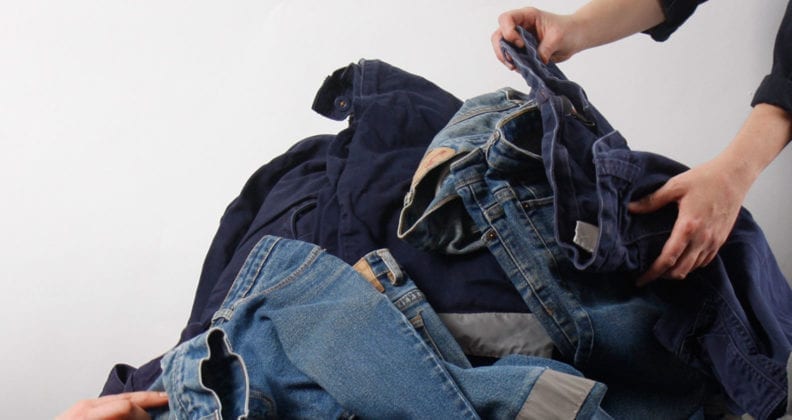Sustainable fashion: Curtin grads team up for ‘Fibre Economy’ workwear

In Perth, three young women have established a non-profit enterprise to help promote the role of clothing in the ‘the circular economy’.
As more and more consumers recognise the environmental impact of fast fashion, word is spreading – from the houses of haute couture to outback industry – about the need for sustainable fashion design.
Friends and former housemates Molly Ryan and Claudi Janse Van Rensburg became sustainable fashion enthusiasts while studying fashion design at Curtin.
With the support of Curtin, both Molly and Claudi completed internships at the Hong-Kong based organisation Redress, although at different times during their course. Redress is the world’s largest and most pro-active organisation in sustainable fashion design, and it provided the two Curtin students with an aspirational experience.

Together with friend Shannon Itzstein, Molly and Claudi went on to establish a recycling enterprise called Fibre Economy, which redistributes second-hand workwear from mine sites to those who need them.
“Shannon works in WA’s northwest, where she saw a lot of workwear being discarded in good condition, or even brand new,” Molly explains. “Mine site workers receive several uniforms each year – they’re good quality cargo jeans and cotton shirts, but not everyone needs to replace their workwear that often.
“So we’ve arranged for the unwanted clothing to be sent to us. We sort the clothes and send the new and worn jeans to employment charities that help people transition into the workforce.”
Even the ‘unwearable’ items aren’t wasted – they’re given to Curtin fashion design students for projects in upcycling.
Almost a year later and Fibre Economy is more popular than they’d imagined, with charities across Western Australia and the Northern Territory supporting their initiative.

No time for fast fashion
The rampant consumption of cheap apparel, often called ‘fast fashion’, is a major contributor to the fashion industry’s shameful environmental impacts. While textile and clothing factories in some countries are known to have caused smog and polluted waterways, less attention has been given to the impact of mass-produced clothing at the other end of its short lifespan.
Fast fashion has caused us to lose our connection with our clothes, Molly believes, with most opting to discard and replace, rather than treat clothes as an investment and make time to mend them.
“I come from a long line of seamstresses, and from a young age my mother instilled in me an appreciation for well-made clothes.”
She adds that although growing up in Margaret River gave her an innate respect for the natural environment and hand-crafted textiles, her passion for sustainable design methods was inspired by Curtin lecturers, Dr Anne Farren, Dr Kelsey Ashe Giambazi and Jill Morrall.
“Anne is a true a pioneer in sustainable fashion education in Western Australia,” she says, appreciatively.

“We learned how to upcycle garments and textiles for new designs. Dyeing, rearranging, manipulating. Reworking them on the body – it’s very creative.
It was also at Curtin that Molly learned “the ugly truth about the fashion industry”.
“People used to make do with only four sets of clothes. Now, most fashion consumers wear only a small portion of what they own,” she adds.
But the problem of excess isn’t originating in the high-fashion houses of Milan, London, New York and Hong Kong.
While haute couture might be impractical, fanciful and ephemeral, it rarely becomes landfill. And if it does, the textiles that luxury fashion prefers – silk, wool, cashmere and linen – are all biodegradable.
“The value placed on haute couture, and its tendency to be kept in rotation and admired years after it hits the shelves, is positive,” Molly explains.“Much of the polyester produced by fast fashion still exists … but mostly in landfill.”
The environmental impacts of non-biodegradable textiles are piling up. Of the 100 billion fashion items produced globally every year, more than 70 per cent will end up in landfill. In Australia alone, the ABC’s War on Waste program has revealed, we discard 6,000 kilograms of clothes every 10 minutes.
Most of that is synthetics like polyester, spandex and nylon – which may take hundreds of years to break down. And being plastic, polyester will release microplastic pollutants into your washing water and out into the environment, Molly points out.
She’s about to graduate with a degree in fashion design, and has plans to further promote sustainable fashion through creative upcycling workshops and education.
“Reducing the environmental impact of the fashion industry has to be consumer-driven. Circular fashion – where we intercept the clothing at post-consumer stage – helps to keep the resources in a closed-loop system.
“Fibre Economy is a work in progress, but it’s making a difference.”



